Grant Stone vs Alden Loafers: New School vs Old School

Expert Verified By: Ticho Blanco | Boot Photographer & Marketing Expert
Today we’re looking at smart casual loafers from two brands that are constantly compared with each other: Grant Stone and Alden.
While they both make extremely high-quality, Goodyear welted footwear with similar materials, the price gap is immense.
You could argue that while they both lean smart casual, Grant Stone is a more modern version of Alden: online vs. brick-and-mortar, and made-in-China vs. made-in-America.
“Alden have been around since the late 19th century, they’re old school. Just one of the last remaining vestiges of what was once a huge industry in the United States. They still manufacture in Massachusetts and they’re still family owned and run,” says Stridewise expert Ticho Blanco. “Grant Stone are the exact opposite of Alden in a lot of ways: a more modern company embracing the Internet, embracing the online community, and manufacturing in China.”
Ticho and I have been wearing (and posting about) both of these brands for the better part of a decade, so we’re well positioned to explain what makes folks pick one over the other.
From the stitching to the sole, we’re going to cover everything.
Key Takeaways: Grant Stone vs Alden Loafers
Differences:
- Grant Stone’s loafers come in at nearly half the price and have a wider range of leathers and colors.
- Grant Stone is easier to purchase because they have their own online store and far more sizes and colors in stock.
- Alden’s loafers are made in America, Grant Stone’s in China.
- Alden offers unlined loafers, which some prefer for warm weather or a firmer fit. Lined loafers, meanwhile, hold their shape better with time.
Similarities:
- Both Alden and Grant Stone have Goodyear welts, hand stitched aprons, steel shanks, and leather soles.
- Both use leather from Horween Leather Company, though Grant Stone has more options from other tanneries.
- Both have an unusually wide array of widths, though Alden has trouble keeping them in stock.
- Both are great examples of the smart casual loafer: not too dressy or too casual.
Our Experts
We spoke to Ticho Blanco, an influential marketing consultant in the world of high-end boots and shoes. Ticho’s an expert in footwear construction, fitting, leathers, and everything else you need to know about what qualities make the best loafer.
In addition to co-hosting the Stitchdown Shoecast, his business centers on helping footwear brands from overseas break into the American market. He therefore has an extraordinarily well honed understanding of what differentiates upscale loafer models and what their clientele tends to value.
Further Reading

10 Best Loafers For Men Expert Tested | Horsebit, Penny Loafers & More
Only one of these brands made my top 10 loafers list. Learn more →

Grant Stone vs Alden: The Brands
Alden has been making shoes in the US since 1884 and even invented the tassel loafer. Grant Stone was only founded in 2016, but there’s a strong link between the two brands.
Grant Stone Overview
Founder Wyatt Gilmore‘s father and grandfather sold Alden footwear for decades. Even the name, Grant Stone, comes from an Alden employee who worked with Wyatt’s grandfather.
Available in over a dozen leathers, this loafer is ubiquitous because of its versatility, tight QC, ease of sizing, and uncommonly durable Goodyear welt construction.
Wyatt’s father worked with factories in China to create similarly high-quality Goodyear welted shoes, in the spirit of Alden, at a more accessible price. Wyatt himself spent years living in sunny Xiamen, China, to learn everything he could about managing a brand before founding Grant Stone in 2016.
Today, Grant Stone make three styles of loafers: a tassel loafer, horsebit loafer, and the bestselling penny loafer called the Traveler, which is what we’re focusing on.
Alden Overview
Founded in 1884 by Charles H. Alden in Middleborough, Massachusetts, Alden is an old-school brand that doesn’t sell their own shoes, instead emphasizing their brick and mortar stores as the best place to try them out. (Some websites, most notably The Shoe Mart, sell them online — but they add their markup. Alden is not a direct-to-consumer brand.)
“Where everybody else got offshore, purchased by venture capital, and kind of destroyed, Alden have remained,” says Ticho. “It’s like you’re buying shoes from somebody a hundred years ago.”
That’s just what a lot of people love about them — and it’s just what drives away others.
I’ve written a ton about their famous Indy boot worn by Harrison Ford in the Indiana Jones films. But we’re in Loafer Land, and the model we’re contrasting with Grant Stone is Alden’s Leisure Handsewn Loafers (LHS) penny loafer.
These Goodyear welted masterpieces are crafted from the world's finest leathers, including the legendary Horween's Color 8 Shell Cordovan.
Further Reading

The 7 Types of Loafers for Men
We take an in-depth look at 7 types of loafers from penny loafers to dress loafers and more. Learn more →

Grant Stone vs. Alden Construction
- Both use Goodyear welt construction
- Both have hand-stitched toes
- Primary difference is that Alden offers unlined loafers and loafers with more flexible soles
- Lined loafers hold their shape better
- Unlined loafers conform more to the foot and are a bit more comfy in the heat
It’s more common to see a Blake stitch on loafers than the hardier Goodyear welt because the Blake method makes for a shoe that’s lighter, more flexible, and cheaper to make. But both Alden and Grant Stone’s loafers are Goodyear welted, so they’re both unusually durable and water resistant.
Some Aldens are sold as “flex welt,” which use a different leather for the outsole that is indeed more flexible. It’s also a bit thinner and less sturdy feeling as a result, so you can decide what’s more important to you.

The Lining
The presence or absence of a lining is a deal breaker for a lot of guys for a few reasons: breathability, structure, and the more nebulous idea of comfort.
The main difference in how they’re built is that Grant Stone only offers leather lined loafers while Aldens can be bought lined or unlined.
“Over time, unlined loafers are going to end up looking more casual because they collapse a bunch, they’re going to look floppy — in a good way!” says Ticho. “Whereas with lined loafers, you can keep dressing them up as they age because they’re going to hold their shape better.”

Still, some guys prefer unlined loafers.
“It’s a really flexible upper on the Aldens, it’s just suede — or cordovan or leather — and that’s going to form to your foot super nicely,” says Ticho. “So they’re great for wearing barefoot or wearing in the heat. Once spring and summer hits, this is what I want to have on my feet. A lining adds another layer that’s going to keep the heat and moisture in.”
The takeaway is that you have more options for flexibility and breathability with Alden.
Further Reading

Grant Stone Traveler Loafer Review | The Most Versatile Loafer on Earth
Check my full review of Grant Stone’s Traveler loafers. Learn more →

Handsewn Moc Toe vs. Genuine Handsewn Mocassins
Something that differentiates a loafer from a slipper is the moc toe stitching. Native American moccasins inspired this style, and it’s one of the reasons that loafers and other moc toes are considered uniquely North American.
Sometimes a moc stitch is purely decorative, made by pinching a piece of leather and stitching through it so it just looks like it’s bringing two pieces of leather together. Other times, like in the case of Red Wing’s moc toe, it is indeed two pieces of leather being sewn together, but the rest of the shoe/boot is the same construction as a plain toe version.
Then there’s the increasingly rare genuine handsewn moccasin, wherein one piece of leather wraps underneath the foot and is stitched to the “apron” over the toe. This means there are fewer seams and the upper molds a little better to the shape of the foot.
But neither Alden nor Grant Stone’s loafers are genuine handsewn, so you can just look at our visit to a factory that makes them if you want to learn more about that.

Alden and Grant Stone both stand out by using handsewn moc toe stitching. In this case the toe is still one piece of leather and the moc stitch is decorative, but that decorative stitch has been sewn by hand, not machine. This is considered a luxury touch.
“I think Alden only have two older folks who still do that, and as a result, it is getting a little hard to get your hands on the LHS models from Alden,” says Ticho. “There’s a longer wait if you’re trying to preorder it or get an unusual size or width as a result of needing that hand work.”
When he says “longer wait” he’s talking about one or two years to get an out-of-stock LHS. Grant Stone, meanwhile, always has a huge variety of Travelers ready to ship the day after you order them.
Grant Stone vs Alden’s Loafer Leathers
- Alden is very traditional, sticking to shades of black, brown, and burgundy
- Grant Stone sells a wider range of leathers, while also selling most of the leathers Alden uses
- Alden is more likely to have Cordovan available; Grant Stone’s sell out quickly and only replenish once or twice a year
A big differentiator is the leathers you can get. Alden is very old-fashioned as far as a their “brand” goes, sticking to a very traditional range of browns, blacks, and tans. Mostly cow, calf, and cordovan in smooth leathers and suedes.
“They are very rigid about what they’re doing because it’s worked for a long time and they’re not going to change it,” says Ticho.
They’re extremely high quality leathers (mostly from Chicago’s Horween, they won’t say where the suede’s from) and their cordovan loafers are among the most beloved on Earth — but Alden’s a classic kind of company and you’ll never find pink suede or green kangaroo on an LHS.
You know where you will find fun leathers, though?

Grant Stone does a better job of telling you where all their leather comes from. It’s in their interest to convince you of their quality because so many people are skeptical of the fact that they’re made in China, but the leathers come from the world’s most celebrated tanneries like Chicago’s Horween, England’s CF Stead, and Italy’s Maryam.
Grant Stone also has a much wider variety of leathers. If you’d like a loafer like Alden’s natural Chromexcel or brown suede, you can get a Traveler in the exact same leathers.
But they also get a lot weirder and more exotic than stuffy old Alden, like “Coral” pink suede, “Jungle” green kangaroo, and sky blue kudu. Alden rarely even sells something as unusual as a blue loafer, while Grant Stone sells four different ones at the time of writing.
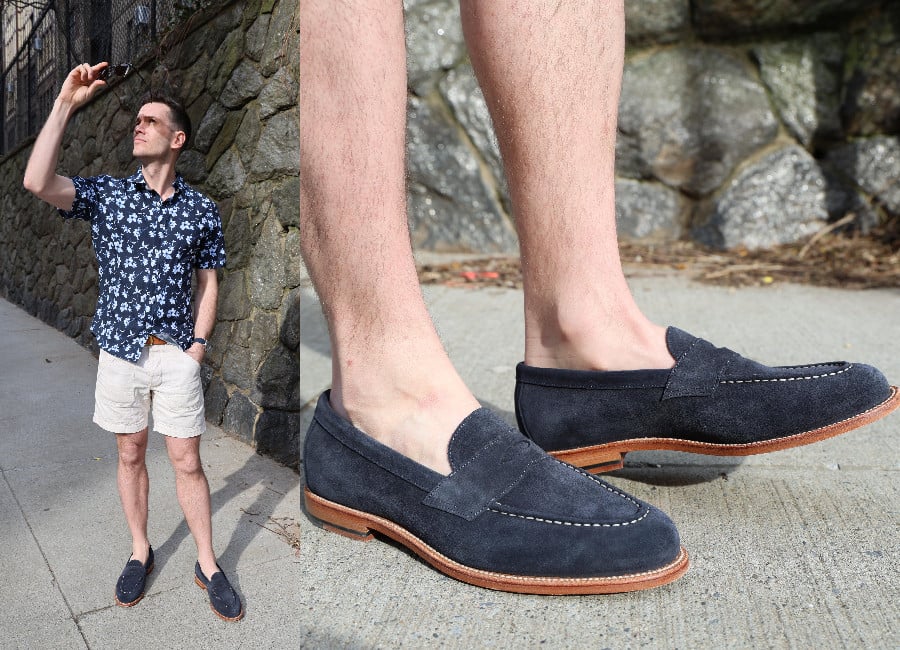
They have over a dozen leather options for loafers and will drop a Shell Cordovan collection once or twice a year that sells out very quickly.
Personally, I’ve got two different pairs of Travelers: one with leather from Horween’s world famous Chromexcel leather and the other in the “Midnight” blue suede from CF Stead.
As it happens, I’ve actually visited CF Stead’s tannery to see how they make their product and I visited Horween to see how they make theirs. That’s how darn famous they are: I spent a bunch of time to go visit them!
Available in over a dozen leathers, this loafer is ubiquitous because of its versatility, tight QC, ease of sizing, and uncommonly durable Goodyear welt construction.
These Goodyear welted masterpieces are crafted from the world's finest leathers, including the legendary Horween's Color 8 Shell Cordovan.

Grant Stone vs Alden Loafer Soles
- Both use leather soles
- Alden has “Flex Welt” options that are more flexible, though a little thinner
Both brands use leather soles and put a little rubber on the heel for extra traction.
“Relative to an all rubber sole, leather’s going to breathe better, and it’s going to flex better,” says Ticho. “In a loafer, the sole has got to move with your foot.”
Grant Stone describes their leather soles as butyl treated, meaning been dipped in oils that are meant to make it a little grippier and more water resistant.
Alden’s edge is that they have flex welt soles as an option, which is a thinner and more flexible leather sole. Some like the flexibility, others prefer more sturdy feel of a classic leather sole. You’ve got both options.
Further Reading
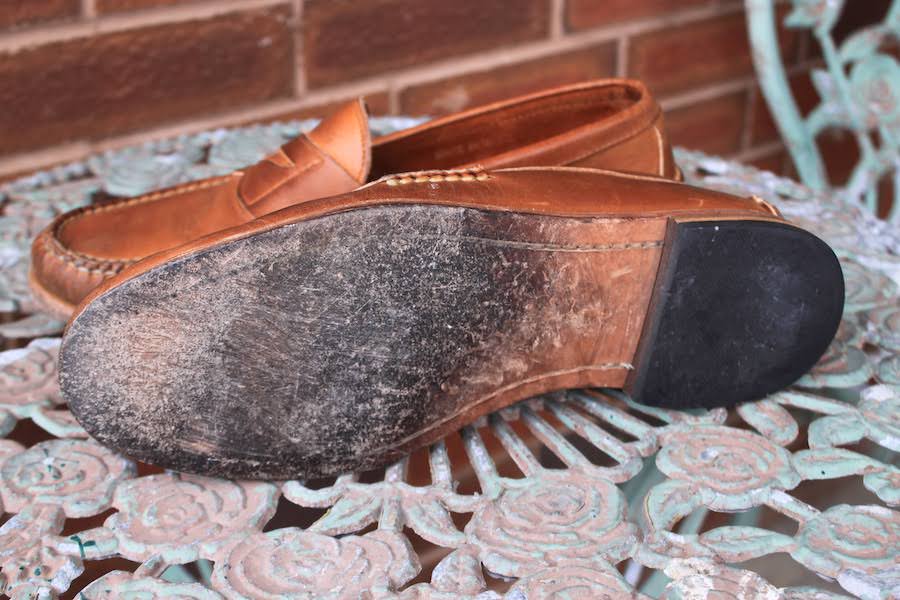
The Pros and Cons of Leather Soles
I was skeptical about leather soles, but they’re more hardwearing than you think! Learn more →
Grant Stone vs. Alden Loafer Fit & Sizing
- Both brands fit about the same
- Size down half a size from your Brannock size
- For unlined suede Aldens, consider going down a whole size as they’ll stretch
- Since Grant Stones are lined, don’t expect them to stretch much
- Grant Stone has more sizes available, they ship faster, and it’s easier to exchange
“I take the same size in both,” says Ticho. “I’m an 11-D Brannock, and 10-and-a-half D has worked out great for me.”
Grant Stone are great at responding to sizing questions on their Instagram and via e-mail. Alden aren’t. They have the advantage of having a lot of stores around the US where you can try them on first. Grant Stone has the advantage of being responsive to online queries and they offer free returns and exchanges. There are pros and cons to both brands’ approaches.
“One of my favorite things that Grant Stone does is that they have all these sizes,” says Ticho. “They have them in stock in a warehouse in Michigan. If you reach out to them and say, hey, here’s what I wear in different [brands], they’re going to give you a good recommendation. They’re going to probably get you the right size the first time, and if not, they’ll swap it out.”

Grant Stone vs Alden Pricing
There’s no shame in the price being the deciding factor for you — especially when there’s as wide a gap between brands as this.
Grant Stone Pricing
- $348 to $380 (excluding Cordovan)
Grant Stone is half the price for about the same quality. I’m not exaggerating: the construction, materials, and quality control are very similar, and the customer service and buying experience for the online customer are vastly superior.
Available in over a dozen leathers, this loafer is ubiquitous because of its versatility, tight QC, ease of sizing, and uncommonly durable Goodyear welt construction.

Alden Pricing
- ~$650 – $700 (excluding Cordovan)
“Steep,” says Ticho. “Pretty steep.”
So why is Alden so much more expensive? Pedigree, prestige, and paucity.
“If being made in the USA matters to you, if having it sewn by hand and made with these great materials matters to you, there’s nothing else that you can get,” he explains. “If you want to support the United States’ shoe manufacturing industry because you feel so deeply that you don’t want to buy things that are made in China, but you still don’t want to buy $700 loafers, then guess what? You’re not going to be able to get any Goodyear welted loafers that are made in the US.”
These Goodyear welted masterpieces are crafted from the world's finest leathers, including the legendary Horween's Color 8 Shell Cordovan.
Wrapping Up
So which brand should you buy?
If you want a Goodyear welted loafer made in the United States, you won’t find it cheaper than Alden. (If you don’t mind a Blake stitched loafer, you do have a few American-made options from brands like Rancourt and Oak Street.)
Some feel that Alden’s lumbering dinosaur of a business model, refusing to sell online directly to consumers and cleaving to the 19th century brick-and-mortar model, should put them out of business. But we confess there’s an advantage to having the option of trying them on in store, especially when it comes to laceless loafers. That, the fact they’re American made, and their heritage are important.
Still, you’re reading this online, you’re purchasing online, and we’d say it’s factual that Grant Stone offers a vastly superior customer experience. Plus you’re way more likely to find your size and width in stock, you’re spending half as much, and you get more leathers to choose from.
“I appreciate both these companies and love what both of them are doing,” says Ticho. “Alden is holding this tentpole of this former great industry in this country, while I love Grant Stone’s approach of bringing it to the modern age.”


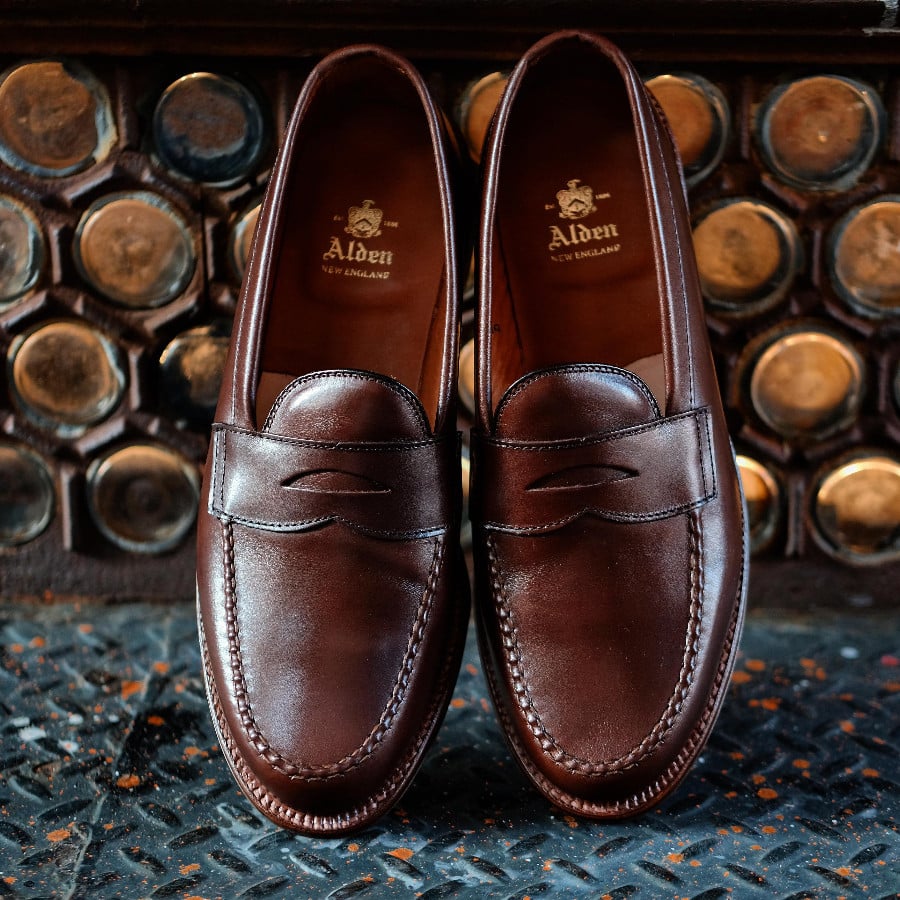






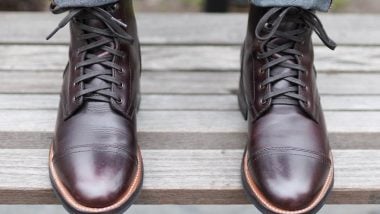

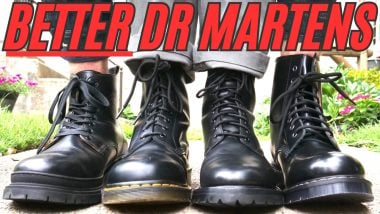
Join the Discussion